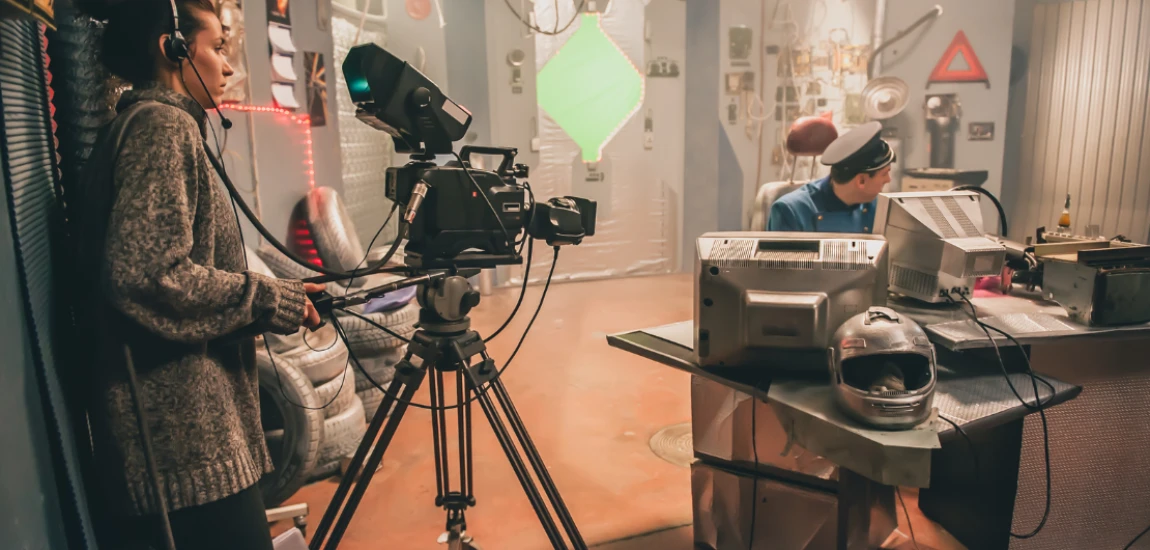Behind the Scenes of Virtual Sets: How Pakistani & Indian Films Are Using Unreal Engine

A new chapter for filmmaking
Virtual production is rewriting the filmmaking playbook. In Pakistan and India, directors and producers are embracing technologies like Unreal Engine to create hyperrealistic environments that merge digital artistry with traditional cinematography. This shift isn’t just about flashy visuals—it’s about efficiency, creative freedom, and breaking geographical limits.
Why Unreal Engine is the tool of choice
Developed by Epic Games, Unreal Engine has become the gold standard for real-time 3D environments. Originally built for gaming, it’s now powering film sets across the world. Its appeal lies in its ability to render cinematic-quality visuals in real time, letting filmmakers preview entire scenes before the cameras even roll.
The South Asian adoption wave
In the last three years, film industries in Karachi, Lahore, and Mumbai have begun experimenting with LED volumes and virtual backdrops. This marks a turning point—South Asian cinema, once constrained by budget and location, can now compete with international visual standards without leaving the studio.
How Unreal Engine Transforms Traditional Filmmaking

From green screens to real-time sets
For decades, South Asian filmmakers relied on green screen compositing to achieve fantastical or distant worlds. But green screens often made lighting and reflection integration challenging. Unreal Engine changes this entirely. By projecting 3D worlds on massive LED walls, actors perform within immersive digital environments that react to real camera movement.
Dynamic lighting and natural integration
The lighting flexibility of Unreal Engine is transformative. Directors can simulate sunsets, city lights, or mountain reflections with precision. Cinematographers now control virtual suns and atmospheres just as they would physical lights. The result is seamless blending between real and virtual elements—something green screens struggled to achieve.
Real-time creative control
In traditional post-production, visual effects took weeks or months to finalize. Now, directors see the results instantly on set. They can tweak backgrounds, camera angles, or visual tone in real time, saving both time and money.
Case Studies: How Pakistani & Indian Filmmakers Are Leading the Way

Bollywood’s leap into virtual sets
Indian cinema has always pushed the envelope with large-scale production design. Films like Brahmāstra, Adipurush, and several Netflix India originals experimented with virtual set elements powered by Unreal Engine. While early results were mixed, the industry quickly learned how to blend practical sets with digital volumes for more believable worlds.
Pakistan’s growing virtual studios
In Pakistan, a new generation of filmmakers is quietly revolutionizing production. Karachi-based studios such as WaqarTech and PostEx Visuals have begun offering LED volume services powered by Unreal Engine. Music videos, TV commercials, and indie films have already started using virtual stages to create stunning, cost-effective results.
Regional collaboration and training
Cross-border workshops and collaborations between Indian and Pakistani VFX artists are emerging online. Virtual production academies now offer specialized courses on Unreal Engine, teaching South Asian storytellers how to use the same tools as Hollywood.
The Creative Advantages of Unreal Engine

Limitless worlds, smaller budgets
One of Unreal Engine’s biggest advantages is scalability. Directors can build entire digital cities or landscapes for a fraction of the cost of physical sets. This democratizes creativity—allowing small studios and independent creators in South Asia to compete visually with global productions.
Enhanced performance and immersion
Actors no longer perform in front of blank walls. Instead, they see the world around them—the desert, the palace, the futuristic city—making performances more authentic. Emotional cues become stronger because the environment is tangible and responsive.
Faster production cycles
Virtual sets significantly cut down on travel, logistics, and set construction. What once took weeks can now be achieved in hours. Directors can shoot multiple “locations” in one day, switching backdrops instantly without moving an inch.
The Technical Backbone: How Unreal Engine Works on Set

LED volumes and camera tracking
The backbone of virtual production lies in LED volumes—large curved walls made of LED panels displaying 3D environments. Unreal Engine syncs these visuals with camera tracking systems. As the camera moves, the background shifts perspective accordingly, creating the illusion of depth and realism.
Real-time rendering and lighting control
Unlike pre-rendered CGI, Unreal Engine allows live rendering, meaning directors can see the final frame—including VFX—immediately. Lighting can be adjusted on the spot, eliminating much of the guesswork that used to occur during post-production.
Integration with existing tools
Unreal Engine integrates seamlessly with other filmmaking tools like Maya, Blender, and Nuke. This makes it easier for South Asian studios already using traditional pipelines to incorporate virtual production without a steep learning curve.
Challenges, Opportunities, and the Future of Virtual Filmmaking in South Asia

The challenges: cost and expertise
Despite its potential, virtual production is still expensive. Building an LED volume and training technicians require significant investment. Many Pakistani and Indian studios struggle to access the hardware or skilled labor needed to operate Unreal Engine at its full potential. However, smaller mobile stages and cloud-based rendering are beginning to reduce these barriers.
The opportunities: democratizing visual storytelling
As costs fall, virtual production will become as common as digital editing. South Asia’s vibrant storytelling traditions—rich with mythology, fantasy, and spectacle—are perfectly suited for Unreal-powered worlds. Imagine Pakistani folklore or Indian epics recreated with cinematic realism and local authenticity.
The future: collaboration and innovation
The next five years will likely see regional co-productions using shared virtual stages. Streaming platforms like Zee5, ARY Digital, and Netflix South Asia are already investing in Unreal-based projects. This could turn South Asia into one of the fastest-growing hubs for virtual filmmaking.




